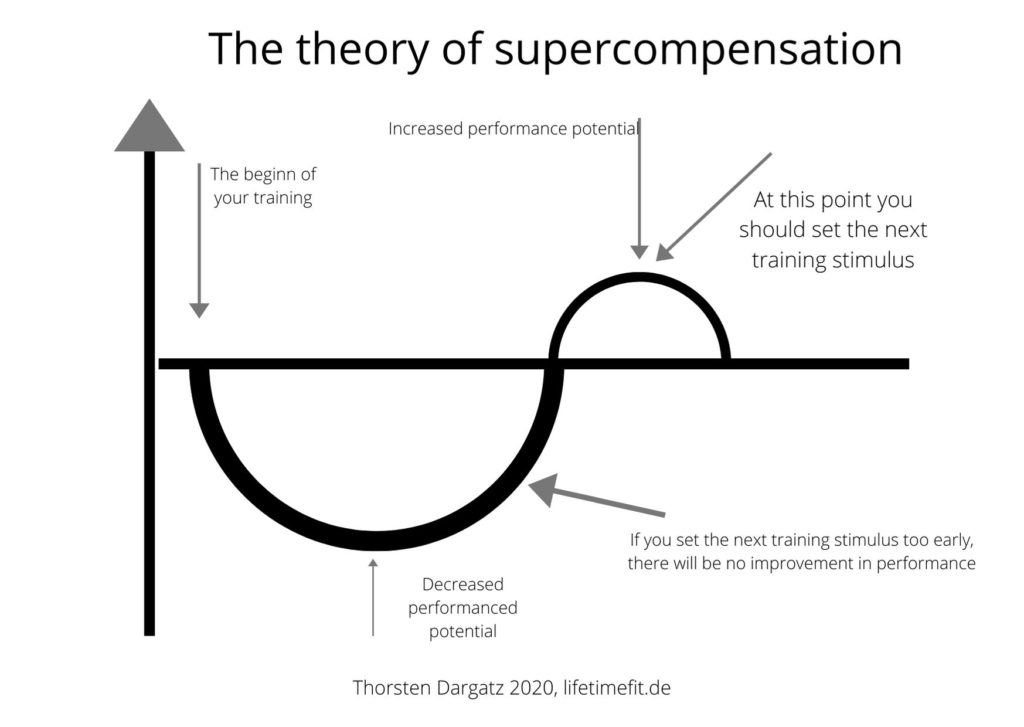Supercompensation or how to continuously improve

It does not matter whether you are a beginner, recreational athlete, ambitious athlete or professional. If you do sport regularly, you set certain processes in your body in motion. Ideally, these lead to continuous performance improvement and adaptation symptoms. But all this only works if you are familiar with an important principle of sports science: supercompensation.
How supercompensation makes you better
Our organism rewards all those who adhere to the interplay of stress and recovery during training. After all, performance capacity increases continuously. The heart grows, the strength of the muscles increases and they also function better. Tendons and ligaments also become stronger and new blood vessels sprout, ensuring an optimal supply of oxygen to the whole body.
The law of supercompensation
Many scientific studies have shown that many athletes do not adhere to the law of super-compensation. With undesirable consequences: Performance stagnates or drops, injuries occur more frequently and the immune system weakens. To avoid this, it is advisable to take a closer look at the whole thing and these principles:
Principle 1: You must systematically weaken in order to become stronger. It sounds paradoxical, but I will explain it in a moment.
Principle 2: After you have weakened your body through training, you have to give it the chance to recover.
Principle 3: If you set the next strain too early, you will get an overtraining syndrome. Your performance stagnates or diminishes.
Principle 4: If you wait too long with the next load, you basically start all over again. Improvements in performance are then hard to be expected.

How supercompensation makes you fitter
Timing is, therefore, the decisive factor. When you start training, fatigue processes start at the same time. Your performance decreases. Directly after the end of the training, regeneration begins. Your performance increases again and even goes beyond the initial level. Experts call this oscillation behavior. At the peak of this phase – called super-compensation – the next load should ideally follow. This again leads to fatigue. After training, regeneration sets in, supercompensation occurs again, and so on and so forth. Continuous performance improvement occurs when you set the next training stimulus at the highest point of supercompensation. See graphic:
The timing of supercompensation
A planless training, without consideration of the vibration behavior, therefore leads to a drop in performance. Therefore it is important for every athlete to know how long the body needs to recover after a load. Or even better, when the next training session should ideally follow. Here is the chronological overview:
- Pure aeorobic training: The body regenerates already during the training. So theoretically it is even possible to do this kind of exercise twice a day.
- Aerobic-anaerobic training: At a load of 75 to 85 percent of your maximum performance capacity (for example during interval training, mountain runs or stair training) the body needs 24 to 48 hours to regenerate, depending on the performance capacity.
- Anaerobic training: At loads that correspond to 90 percent of your maximum performance capacity, it takes 48 to 72 hours to regenerate. It is depends on your performance level. Training with an effect on the neuromuscular system (e.g. functional fitness, circuit training): up to 72 hours.
What does that mean for your training?
If you train without a plan and possibly set the next load too early, your performance will be reduced. With purely aerobic training, the danger is low. But if you want to get more out of your running training, you should set more training accents. This includes not only faster runs but also strength training. Why strength training, I will explain later in this book. If you are happy about a successful training session, then you must be aware that the success of your training now depends crucially on how you regenerate afterward.

These factors influence your regeneration:
- enough sleep
- a well-balanced diet
- physical measures (massage, sauna, …)
- mental relaxation and balance
- personal milieu
- other factors (food supplements, alcohol, nicotine, caffeine, medicines, diseases, …)
All factors are individually different, so you need to know thyself!
Experiment with your body! If you find the training difficult each time, you should reduce the intensity or extend the recovery periods. The same applies if you stagnate. It can also be useful to set completely different training stimuli. The more varied the training, the better. If you find the training easy, you can also increase the intensity.
1 thought on “Supercompensation or how to continuously improve”